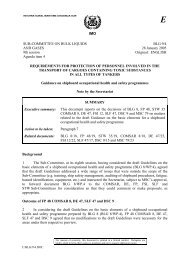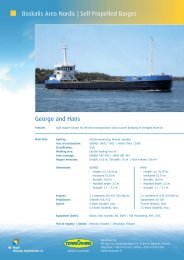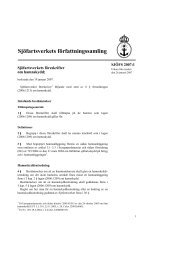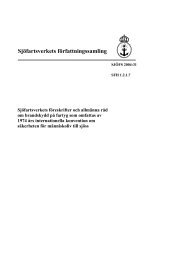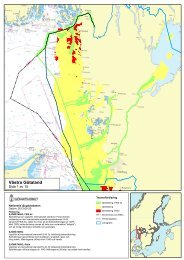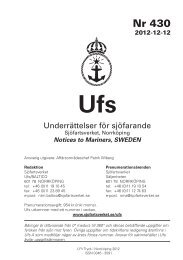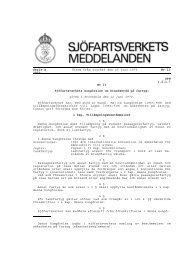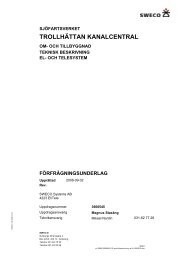AIS - Automatic Identification System
AIS - Automatic Identification System
AIS - Automatic Identification System
You also want an ePaper? Increase the reach of your titles
YUMPU automatically turns print PDFs into web optimized ePapers that Google loves.
<strong>AIS</strong><br />
for ships in the future<br />
AUTOMATIC IDENTIFICATION SYSTEM<br />
Introduction<br />
<strong>Automatic</strong> <strong>Identification</strong> <strong>System</strong> (<strong>AIS</strong>) is a technical system<br />
that makes it possible to monitor ships from other ships, and<br />
from shore based stations. <strong>AIS</strong> is a requirement. (see International<br />
standardisation below). <strong>AIS</strong>-equipped ships continuously<br />
transmit a short message containing information of position,<br />
course over ground (COG), speed over ground (SOG),<br />
gyro course (heading), etc. Ships equipped with <strong>AIS</strong> meeting<br />
anywhere on earth will be able to identify and track each other<br />
without being dependent of shore stations.<br />
Shore stations will also get the same information from<br />
“<strong>AIS</strong>-ships” within the VHF area of the station when monitoring<br />
the coastal areas and the ports. The <strong>AIS</strong> is using a<br />
broadcast and an interrogating self organised technology the so<br />
called <strong>AIS</strong> STDMA/ITDMA that operates ship-to-ship and<br />
ship-to-shore including limited communication capabilities.<br />
<strong>AIS</strong> does not require a radar.<br />
The International Telecommunication Union (ITU) has<br />
defined the technical standard and ratified the global frequencies.<br />
(see International standardisation below). International<br />
Electrotechnical Commision (IEC) has accomplished the test<br />
standard . (see International standardisation below). This<br />
pamphlet will stress the advantages of the <strong>AIS</strong>, show how to<br />
use it and why the techniques can operate and handle the<br />
information from all ships even in the most dense shipping<br />
waters of the world.<br />
Regina<br />
C=076<br />
S=14.8<br />
This article about the shipborne <strong>AIS</strong> (<strong>Automatic</strong> <strong>Identification</strong><br />
<strong>System</strong>) is published by the Swedish Maritime Administration.(SMA).<br />
Text by Captain/Pilot Benny Pettersson, SMA Sweden, assisted<br />
by Senior Development Engineer Rolf Bäckström, Finland.<br />
Updated Feb 2004 by Rolf Zetterberg.
International Association of Marine Aids<br />
to Navigation and Lighthouse<br />
Authorities (IALA)<br />
presented the first<br />
proposal of <strong>AIS</strong> to<br />
IMO. IALA is mainly<br />
dealing with shore<br />
based aids to navigation<br />
including Vessel<br />
Traffic Services (VTS).<br />
The problem to identify<br />
ships on the radar<br />
displays in the VTS<br />
centres was, however,<br />
one of the reasons for<br />
the VTS committee of<br />
IALA to initiate the<br />
development of a Digital Selective<br />
Calling (DSC) transponder system (<strong>AIS</strong>). Their<br />
operational requirement for the <strong>AIS</strong> was mainly focusing on the<br />
needs of the VTS stations to identify radar targets approaching<br />
the coast. Requirements from seagoing mariners and others<br />
with interest in <strong>AIS</strong> were not looked at.<br />
Who is demanding <strong>AIS</strong><br />
and who could derive advantage from <strong>AIS</strong><br />
The demand from politicians and maritime authorities to<br />
monitor movements of ships in their territorial waters, in order<br />
to prevent accidents and maritime disasters is rapidly increasing,<br />
Coastal states are responsible for traffic separation schemes,<br />
routing areas and fishing areas in their territorial waters.<br />
These states demand compulsory compliance by the users of<br />
these waters and have a need to control “areas to be avoided”.<br />
The fact that users are monitored and identified from shore<br />
will most probably result in a greater compliance with traffic<br />
separation schemes, routing measures and fishing regulations.<br />
It has been argued that accidents in coastal areas could be<br />
avoided, if ships were identified. This is maybe true in some<br />
cases, but a shore based station, identifying a ship, is limited to<br />
advise actions only by using the VHF radio communication<br />
facilities. Furthermore, misunderstandings of the advice can<br />
appear due to, for instance, language problems.<br />
The Exxon Valdez, the Aegean Sea and the Braer were all<br />
identified, long before they ran aground. Consequently, radio<br />
contact is not always the solution.<br />
The only person to stop the engine or change the course to<br />
avoid a grounding or collision is the Officer Of the Watch<br />
(OOW). The OOW is also deciding on actions to follow in<br />
order to comply with the Collision Regulations (COLREG).<br />
Ships equipped with <strong>AIS</strong> enables the OOW´s to be the first<br />
ones to benefit from the <strong>AIS</strong> system by getting an improved situation<br />
awareness capability.<br />
Ambiguous calls, with a stressed voice, in the night, as:“Ship<br />
on my starboard side, ship on my starboard side, this is M/S XXX,<br />
I am turning to port”, have made many OOW´s wishing for an<br />
<strong>AIS</strong> to identify M/S XXX and to get the information about<br />
when and how much M/S XXX is turning and to whom she is<br />
directing her call. All the OOW´s, within radio range, will be<br />
put under severe stress due to this inaccurate and incomplete<br />
information. The stress will last until at least the ARPA radar<br />
equipped ships, after two to three minutes, will detect that one<br />
of the targets on the display is turning and might be M/S XXX.<br />
It has been argued that OOW´s, onboard <strong>AIS</strong> equipped ships,<br />
sometimes will actively agree on actions in conflict with<br />
COLREG, due to their knowledge about the name of the other<br />
ship.<br />
This might happen, but one must not forget that mariners<br />
make such calls anyway today without knowing whom they are<br />
addressing. To prohibit the OOW to use <strong>AIS</strong> would be like to<br />
prohibit the use of radar.<br />
Pilots, barge captains, ferries etc.<br />
In very busy areas, as harbours, rivers and archipelagos, the<br />
need for a high update rate mode <strong>AIS</strong> is evident. The<br />
limitations of the ARPA radar to track ships due to target<br />
swapping from a ship to land, beacons, bridges and other ships<br />
makes the ARPA capabilities very limited in narrow and<br />
congested waters.<br />
Today there is a strong feeling among mariners navigating in<br />
harbours, rivers and archipelagos, that <strong>AIS</strong> will improve the<br />
safety and to a great extend solve the “limitations of the radar”<br />
due to the following <strong>AIS</strong> capabilities:<br />
• “Look behind” a bend in a channel or behind an island in the<br />
archipelago to detect the presence of other ships and identify.<br />
• Predict the exact position of a meeting with another ship in a<br />
river or in an archipelago for instance to avoid narrow areas.<br />
• Identify the ships port of destination.<br />
• Identify the size and the draft of ships in vicinity.<br />
● Detect a change in a ship’s heading almost in real time.<br />
● Identify a ferry leaving the shore bank in a river.<br />
● Identify fixed obstacles, like oil rigs, ship wrecks, dangerous<br />
to shipping.<br />
● Identify slowly moving targets, like log rafts, sounding arrays<br />
etc., which are unable to take rapid evasive actions.<br />
2 <strong>AIS</strong> for ships in the future
Radar<br />
<strong>AIS</strong><br />
139 17<br />
Target<br />
Mariella<br />
IDG<br />
COG<br />
SPEED<br />
ROT<br />
Flint VTS Malmö.<br />
VTS<br />
Radar is today the main sensor of the VTS to detect a ship.<br />
The VTS radar has almost the same errors in range and bearing<br />
resolution as all other radar’s, although it has a known position<br />
and is North oriented without the errors of a compass<br />
involved. The limitations, of the ARPA radar to track ships due<br />
to target swap to land, beacons, bridges and other ships, makes<br />
the tracking facility in the ARPA rather limited.<br />
VTS’s are today limited to track ships, for instance, in a bay<br />
or when approaching a harbour from sea. There is a requirement<br />
for improving of the VTS to be able to:<br />
● Cover areas where radar coverage is almost impossible to<br />
achieve, like rivers and archipelagos.<br />
● Identify radar blips on the VTS radar automatically.<br />
● Interrogate ships for information regarding type of cargo.<br />
● Track with a high up date rate, the ferry going between two<br />
ports in the bay or a river continuously, without needing to<br />
<strong>AIS</strong> for ships in the future 3
do it every time the radar tracking has swapped to another<br />
target or, when the ferry has been moored to a pier or passed<br />
too close to a beacon or a passing ship.<br />
● Know which port a ship is bound for.<br />
● Know the size and the draft of ships in the vicinity.<br />
● Detect a change in a ship’s heading almost in real time.<br />
● Identify slowly moving targets, like log rafts, sounding arrays<br />
etc., which are unable to take rapid evasive actions.<br />
The only <strong>AIS</strong> solution, that could solve all the requirements<br />
of the VTS, is a high update rate, mode <strong>AIS</strong>, with interrogating<br />
capabilities.<br />
The establishment of a landbased <strong>AIS</strong> reception network,<br />
may actually mitigate the need for VTS in some areas. The cost<br />
of installing and maintaining an <strong>AIS</strong> network is minute compared<br />
to a VTS radar net-work.<br />
Marine Search and Rescue (SAR)<br />
SAR operations would be much more efficient if all the<br />
Rescue Units (RU) were fitted with <strong>AIS</strong> to quickly identify the<br />
ship closest to a distress situation.<br />
During a search operation all the crafts could be tracked and<br />
plotted enabling the Marine Rescue Co-ordination Centres<br />
(MRCC) to monitor the progress, to direct the available<br />
resources efficiently and to ascertain a search coverage without<br />
gaps. Furthermore, all surrounding ships and RU´s as well as<br />
the MRCC could identify an <strong>AIS</strong> equipped ship in distress.<br />
The actual emergency status of the ship could also be determined<br />
automatically.<br />
Man Over Board (MOB) alarm will most probably be one of<br />
the features allowing all other ships in vicinity to have the same<br />
MOB position displayed, when one of the ships have activated<br />
the MOB alarm.<br />
Fishing boats and pleasure crafts<br />
Most of the small ships will not be equipped with <strong>AIS</strong> which<br />
makes the radar the most important sensor to detect their existence.<br />
If mandatory <strong>AIS</strong> carriage requirement could be applied to<br />
fishing vessels, it would enable national fishing agencies to<br />
enforce fishing restrictions more efficiently.<br />
Shore based pilotage – heading<br />
The captain on a ship with no radar or a radar disturbed by<br />
sea/ rain clutter and with a very weak radar return from shore<br />
and navigational aids, may today be assisted with his navigation<br />
if he is able to get navigational assistance from shore.<br />
Shore based pilotage with radar is normally limited to small<br />
and moderately sized ships which generally are more manoeuvrable<br />
than, for example, large tankers. The limitations of radars,<br />
makes shore based pilotage suitable only in areas where the<br />
navigable water is sufficient to separate the traffic, and where<br />
the ship could be supervised only by giving bearings to, for<br />
example, waypoints.<br />
If only the DGPS position from a ship, but no heading, is<br />
transmitted via the <strong>AIS</strong> the VTS operator will get an exact position<br />
of the ship’s antenna at the moment, as well as the speed<br />
and course over ground for the same antenna. The ships heading<br />
and the position of other parts of the same ship, at the<br />
same moment, is however<br />
unknown. This uncertainty<br />
of the real situation<br />
could lead to mistakes of<br />
importance. For instance,<br />
a 350 meter long tanker<br />
with the antenna situated<br />
on top of the wheelhouse<br />
at the stern, starts to turn<br />
to starboard. The ship’s<br />
course will then change to<br />
starboard, but initially the<br />
stern with its antenna will<br />
swing slightly to port, as<br />
the ship is turning around<br />
its so called pivot point.<br />
There is obviously, besides<br />
to determine and transmit<br />
the exact position of the<br />
antenna, a need to include<br />
the heading in the transmission. The ARPA radar tracks the<br />
part of the ship, which gives the best radar return, normally on<br />
a loaded tanker the superstructure at the stern. A big tanker,<br />
turning with the superstructure at the stern tracked by radar,<br />
could have turned 30-50 degrees, before this is detected by the<br />
ARPA radar, on another ship or at the VTS, and now up to 4-5<br />
minutes has passed since the turn started.<br />
4 <strong>AIS</strong> for ships in the future
the inherent limitations of radars could be solved. The <strong>AIS</strong> also<br />
shows the navigational status of another ship with <strong>AIS</strong>, i.e. that<br />
two ships equipped with <strong>AIS</strong>, that meet in restricted visibility,<br />
have all the information, that the navigation lights could show,<br />
including name and and port of destination.<br />
The heading is taken from the compass and is not affected,<br />
neither when the <strong>AIS</strong> is using a high accuracy nor a low accuracy<br />
positioning sensor. The faster the nominal update rate is, the<br />
faster the mariner on another ship, or an observer in a VTS, will<br />
detect a course change. This means that a ship with high speed<br />
needs a higher nominal update rate than a ship with slow speed.<br />
Type of ship<br />
Ship at anchor or moored<br />
Ship 0-14 knots<br />
Ship 0-14 knots and changing course<br />
Ship 14 – 23 knots<br />
Ship 14 – 23 knots and changing course<br />
Ship >23 knots<br />
Ship >23 knots and changing course<br />
Reporting<br />
interval<br />
3 min<br />
12 sec<br />
4 sec<br />
6 sec<br />
2 sec<br />
3 sec<br />
2 sec<br />
Path prediction<br />
The large potential of transmitting the rate of turn of the ship,<br />
together with all the other movement parameters, is still not fully<br />
recognised. This enables both the VTS and approaching ships to<br />
make a rather accurate prediction of the path a ship is taking,<br />
some 30–90 seconds ahead. This gives more time and better<br />
information for all the other players in the traffic environment to<br />
plan their moves.<br />
Route planning<br />
To be able to improve the tracking and the detection of a<br />
course change of a ship from other ships or from the VTS, ship’s<br />
heading and DGPS antenna position also have to be transmitted<br />
at a high update rate. The best way of transmitting this kind of<br />
information would be, if vessels were equipped with an <strong>AIS</strong> working<br />
in ”Beacon Mode” and a high update rate.<br />
Radar<br />
It has been argued, that with an <strong>AIS</strong> display presenting <strong>AIS</strong><br />
ships, the OOW will forget to ”fine tune” his radar to detect<br />
small crafts. It is important to emphasise, that the radar is and<br />
will remain one of the most important instruments on the bridge,<br />
even in the future. It is important, that the OOW is taught the<br />
difference between the radar and the <strong>AIS</strong>, and the importance of<br />
tuning the radar to detect small crafts without <strong>AIS</strong> onboard.<br />
Anti Collision<br />
The radar has been the primary mean to prevent collisions at<br />
sea in restricted visibility. The necessity to use a plotted ship’s<br />
course and speed through water, to be able to get it’s actual heading<br />
as accurate as possible, is obvious. Still the difference in<br />
course and speed through water, between a tanker and a carcarrier<br />
in a strong wind, is considerable.<br />
With an <strong>AIS</strong> the identification, heading and the change in<br />
heading could be determined with a high update rate and some of<br />
Shipping routes within a VTS area are normally well defined,<br />
including alternative routes between two points, to the point that<br />
they could be indexed. One could anticipate a requirement to<br />
plan the route of a ship in advance, either by the OOW or supplied<br />
by the VTS. In either case the plan, consisting of the appropriate<br />
index numbers could be interchanged utilising <strong>AIS</strong>. This<br />
would enable interested parties to compare the planned route of<br />
the ship with the actual path taken.<br />
Short message communication<br />
The limitation of any radio system with all users on the same<br />
channel is, the capacity. This is true both for voice and data communication.<br />
The proposed <strong>AIS</strong> would make it possible to utilise a<br />
short message scheme, ie. to produce an indexed list of predetermined<br />
traffic messages. There could be addressed (point-to-point)<br />
messages like 1) “You are now within VTS area boundaries”, 2)<br />
“Switch immediately to VHF channel NN” and so on. In the latter<br />
message, the NN is an attribute, to be supplied by the user.<br />
The actual transmitted message is constituted of the index number<br />
only, together with the eventual attribute. If a common list of<br />
messages could be agreed upon, it should be multilingual, thereby<br />
avoiding mis-understandings because of language difficulties.<br />
In order to not impair the main function of <strong>AIS</strong> by overloading<br />
the VHF data link, has IMO (NAV 49) decided to limit the use<br />
of binary coded <strong>AIS</strong> messages. 7 different messages incl. meterological<br />
information is allowed for a trial period of 4 years.<br />
<strong>AIS</strong> for ships in the future 5
Silent VTS<br />
In some areas of the world e.g. rivers and low traffic areas<br />
where the traffic density don’t justify VTS, an idea called<br />
”Selent VTS” has evolved. Instead of installing conventional<br />
VTS’s on shore the <strong>AIS</strong> equipped ships will acct as their own<br />
VTS’s and use the <strong>AIS</strong> to get their situation awareness.<br />
Display presentation<br />
The <strong>AIS</strong> provides several possibilities for displaying the <strong>AIS</strong><br />
information. The minimum required display is a three line<br />
alpanumeric display that presents bearing, distance, name and<br />
all other information in a spread sheet format, enabling the<br />
OOW to make manual inputs and to identify a ship by comparing<br />
baring and range from the radar PPI. Most probably the<br />
minimum display will be very rarely used. Many ECDIS manufactures<br />
are today implementing the <strong>AIS</strong> symbols in their<br />
equipments. Manufactures, as ADVETO, STN ATLAS,<br />
TRANSAS MARINE, ANS, ICAN are already handling the<br />
<strong>AIS</strong> in their softwares.<br />
It is sometimes not possible to present the <strong>AIS</strong> information<br />
on an old radar screen but the new performance standard for<br />
radar which is developed by IMO includes presentation of <strong>AIS</strong><br />
information. <strong>AIS</strong> targets, superimposed on the radar display,<br />
will inform the operator weather the targets are <strong>AIS</strong> equipped<br />
or not.<br />
IEC has a draft proposal for <strong>AIS</strong> symbology to display on<br />
ECDIS and or ENC systems.<br />
To reduce clutter on the radar or the ECDIS display, due to<br />
too many <strong>AIS</strong>’s appearing at the same time the <strong>AIS</strong> symbols<br />
could be “Active” or “Sleeping”.<br />
● “Active” means that a triangle is showing the targets heading<br />
and (if high accurate positions used) the COG/SOG vector.<br />
● “Sleeping” means that the mariner has chosen to suppress<br />
vectors and heading line and only a small green triangle<br />
pointing in the direction of the heading is shown. A sleeping<br />
target could always be activated if the mariner selects it.<br />
High update rate<br />
A modern ARPA radar is able to select and track 20 targets<br />
with an update rate of 3 seconds. The symbol on the PPI will<br />
follow the target, except when a target swap is appearing. Due<br />
to the limitations of the ARPA, a course alteration of another<br />
ship will normally not be detected until one or two minutes<br />
after the course change. For a large tanker it will take up to five<br />
minutes. Further more, another one or two minutes is needed<br />
for the ARPA to present a reliable target vector with course and<br />
speed through the water.<br />
It is obvious that a high update rate is needed for <strong>AIS</strong> targets,<br />
superimposed on a radar display. If the update rate is too<br />
slow there will be situations, when using smaller ranges, where<br />
the <strong>AIS</strong> symbol will not catch up with the radar target.<br />
International standardisation for <strong>AIS</strong><br />
Within ITU<br />
Technical characteristics for a shipborne <strong>Automatic</strong> <strong>Identification</strong><br />
<strong>System</strong> (<strong>AIS</strong>) using TDMA in the VHF maritime<br />
mobile band has been defined by ITU in ITU-R M.1371-1<br />
Frequencies to be used for the universal shipborne <strong>AIS</strong> has<br />
been defined in ITU-R M.1084-3.<br />
Within IMO<br />
Performance standards has been defined in IMO resolution<br />
MSC.74(69) Annex 3<br />
Carriage requirements in SOLAS was originally approved by<br />
MSC 72 and MSC 73. An implementation period from 2002<br />
to 2008 was allowed. In 2001 when the security aspects of <strong>AIS</strong><br />
was highlighted, IMO decided on an accelerated implementation<br />
for ships on international voyages.<br />
<strong>Automatic</strong> identification systems (<strong>AIS</strong>)<br />
All ships of 300 gross tonnage and upwards engaged on<br />
international voyages and cargo ships of 500 gross tonnage<br />
and upwards not engaged on international voyages and<br />
passenger ships, irrespective of size, shall be fitted with <strong>AIS</strong>,<br />
as follows:<br />
1. ships constructed on or after 1 July 2002;<br />
2. ships engaged on international voyages constructed before<br />
1 July 2002;<br />
● in the case of passenger ships not later than 1 July 2003;<br />
● in the case of tankers, not later than the first Safety<br />
Equipment Survey after 1 July 2003;<br />
● in the case of ships, other than passenger ships and<br />
tankers, of 300 gross tonnage and upwards, not later<br />
than 31 Dec 2004;<br />
3. ships not engaged on international voyages constructed<br />
before 1 July 2002, not later than 1 July 2008. However, in<br />
Sweden a faster implementation is required, starting in 2003<br />
and ending 2007.<br />
4. The Administration may exempt ships from the application<br />
of the requirements of this paragraph when such ships will<br />
be taken permanently out of service within two years after<br />
the implementation date specified in paragraph 1. [Additionally,<br />
an Administration may exempt vessels flying its flag<br />
in its domestic trade from carrying <strong>AIS</strong> when operating in<br />
areas where in the judgement of the Administration the density<br />
of shipping does not justify <strong>AIS</strong>].<br />
<strong>AIS</strong> shall:<br />
● provide automatically to appropriately equipped shore<br />
stations, other ships and aircraft information, including the<br />
ship’s identity, type, position, course, speed, navigational<br />
status and other safety-related information;<br />
● receive automatically such information from similarly fitted<br />
ships;<br />
● monitor and track ships; and<br />
● exchange data with shore-based facilities. The requirements<br />
of this paragraph shall not be applied to cases where international<br />
agreements, rules or standards provide for the protection<br />
of navigational information. <strong>AIS</strong> shall be operated taking<br />
into account the guidelines adopted by the Organization.<br />
Within IEC<br />
IEC Technical Committee TC80 is now working hard to define<br />
the test standard for a simplified <strong>AIS</strong> for non SOLAS-ships.<br />
6 <strong>AIS</strong> for ships in the future
The principle of <strong>AIS</strong> STDMA/ITDMA<br />
Each time slot<br />
represents<br />
26.6<br />
milliseconds.<br />
The <strong>AIS</strong> of ship A<br />
sends the position<br />
message in one time<br />
slot. At the same<br />
time it reserves<br />
another time slot for<br />
the next position<br />
message.<br />
The same<br />
procedure is<br />
repeated by all<br />
other <strong>AIS</strong>equipped<br />
ships.<br />
Ship B<br />
Ship C<br />
Ship A<br />
Ships with a self organizing broadcast <strong>AIS</strong> onboard will see each other as soon as they are in radio range.<br />
National and regional <strong>AIS</strong> systems<br />
An <strong>AIS</strong> network covering the Swedish coastal waters and the<br />
large lakes was established in 1997. The system was improved<br />
and updated in 2001. The information from this network is<br />
available to the Swedish Maritime Administration for use in<br />
VTS:s, MRCC, pilot stations, Icebreaking Operation Center<br />
etc. Other Swedish administrations needing information on the<br />
sea traffic also have access to this information.<br />
The Helsinki Commission, working with protection of the<br />
environment in the Baltic area, decided in 2001 that all the<br />
coastal states of the Baltic shall establish landbased <strong>AIS</strong> stations<br />
and exchange the information from these stations. The preparation<br />
for that is under way and presently Sweden, Norway,<br />
Finland and Russia are exchanging <strong>AIS</strong> information via<br />
Internet connections. The information will also be collected<br />
and stored by a central server for creation of traffic statistics for<br />
the Baltic Sea.<br />
The European Union requires in a Directive the member states<br />
to establish shorebased <strong>AIS</strong> system before 1 July 2007.<br />
<strong>AIS</strong> for ships in the future 7
”Being in touch doesn’t mean being in command.” Make the OOW, pilot and the captain the ones, which benefits<br />
the most from an <strong>AIS</strong> system and it will increase the safety of shipping and navigation significantly in the future.<br />
Conclusion<br />
The <strong>AIS</strong> is making the navigation safer by enhancing the possibility of detecting the wherabouts of other ships, even if they are<br />
behind a bend in a channel or river or behind an island in an archipelago. The <strong>AIS</strong> will also solve the inherent problem with all<br />
radars, by detecting fishing boats and smaller ships, fitted with <strong>AIS</strong>, in sea-clutter and in heavy rain.<br />
Innovative technologies like ECDIS and ship-to-ship and ship-to-shore <strong>AIS</strong>, have a big potential in improving safety in the maritime<br />
field in the future. It will also make it possible to identify, track and supervise ships from shore with a much higher and more<br />
sustainable accuracy than with a shore based radar.<br />
<strong>AIS</strong><br />
for ships in the future<br />
AUTOMATIC IDENTIFICATION SYSTEM<br />
For further information please contact: Benny Pettersson, Swedish Maritime Administration, Box 27808, SE-115 93 Stockholm, Sweden.<br />
Fax: +46 8 666 66 90. E-mail: benny.pettersson@sjofartsverket.se.<br />
Rolf Zetterberg, Swedish Maritime Administration, SE-601 78 Norrköping, Sweden.<br />
Fax: +46 11 126 791. E-mail: rolf.zetterberg@sjofartsverket.se.<br />
Luftfartsverkets Tryckeri, Norrköping. 3169 2004




